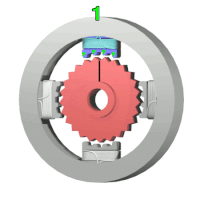
Photo from wikipedia
Dynamic relaxation (DR) is a widely used numerical method to determine the static equilibrium of a dynamic system. However, it is difficult to apply conventional DR methods to nonlinear models… Click to show full abstract
Dynamic relaxation (DR) is a widely used numerical method to determine the static equilibrium of a dynamic system. However, it is difficult to apply conventional DR methods to nonlinear models because they require estimation of a stiffness matrix of the model. To resolve the forementioned problem, a new dynamic relaxation method using continuous kinetic damping (CKDR) was proposed in previous research. The CKDR method does not require any model parameters including the stiffness matrix, and it possesses absolute stability and a second-order convergence rate. However, the convergence rate is proportional to square of the step size, and this may result in a low convergence rate if the selected step size is excessively small. This problem leads to difficulties in the practical use of CKDR. Thus, an adaptive step-size method is proposed in this paper to control the convergence rate of CKDR. The proposed method estimates natural frequency of the model and determines adaptive step size. Static equilibrium simulations were performed for three different models to verify the method. The results revealed that the computational cost of CKDR with a variable step size was very efficient when compared to fixed step sizes and that the convergence rate was also controlled as intended. In addition, the lowest natural frequencies of models in static equilibrium were accurately estimated.
Journal Title: Mathematical Problems in Engineering
Year Published: 2018
Link to full text (if available)
Share on Social Media: Sign Up to like & get
recommendations!